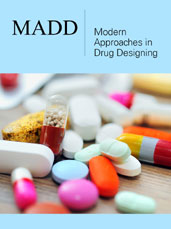- Submissions

Abstract
Modern Approaches in Drug Designing
Thermosensitive Bioadhesive Gel for Periocular Herpetic Lesions: A Mini-Review and Perspective on Polymer-Based Strategies
-
Open or CloseAndreza Maria Ribeiro1*, Thais H S Flores-Sahaguns2 and Fabio Furtado2
1 Post-graduation Program in Department of Engineering and Material Sciences (PIPE), University of Federal of Parana (UFPR), Brazil
2 Department of Mechanical Engineering, University of Federal of Parana (UFPR), Brazil
*Corresponding author:Andreza Maria Ribeiro, Post-graduation Program in Department of Engineering and Material Sciences (PIPE), University of Federal of Parana (UFPR), Brazil
Submission: September 09, 2025;Published: October 09, 2025

ISSN : 2576-9170Volume 4 Issue 5
Abstract
Herpes Simplex Virus type 1 (HSV-1) remains a leading cause of recurrent periocular infections, often resulting in painful lesions, inflammation, and potential vision impairment. Conventional topical treatments, such as creams and ointments, offer limited retention and poor patient adherence, particularly in the delicate and mobile skin surrounding the eyes. This mini-review explores thermosensitive bioadhesive gel as a coadjuvant platform, designed to synergize with natural and synthetic polymers to improve therapeutic performance and user tolerability. The proposed formulation centers on Pluronic F127, a triblock copolymer known for its reversible thermal gelation, low toxicity, and high drug solubilization capacity. When combined with bioadhesive natural polymers such as xanthan gum, alginate, pectin, or chitosan, the gel forms a stable matrix capable of adhering to periocular skin, ensuring prolonged residence time and sustained drug release. In addition to conventional antivirals like acyclovir and ganciclovir, newer agents such as foscarnet, effective against acyclovir-resistant HSV strains, are considered for incorporation into advanced formulations. Expert Perspective: The integration of thermoresponsive and bioadhesive polymers offers a promising route to overcome the limitations of current topical therapies, especially in sensitive anatomical regions. These hybrid systems may redefine the management of periocular viral lesions by combining pharmacological efficacy with enhanced patient experience.
Keywords: Periocular herpetic lesions; Thermal polymers; Pluronic; Natural polymers; Bioadhesive gel; Antivirals
 a Creative Commons Attribution 4.0 International License. Based on a work at www.crimsonpublishers.com.
Best viewed in
a Creative Commons Attribution 4.0 International License. Based on a work at www.crimsonpublishers.com.
Best viewed in 







.jpg)






























 Editorial Board Registrations
Editorial Board Registrations Submit your Article
Submit your Article Refer a Friend
Refer a Friend Advertise With Us
Advertise With Us
.jpg)






.jpg)














.bmp)
.jpg)
.png)
.jpg)










.jpg)






.png)

.png)



.png)






